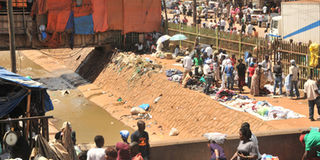Nakivubo Channel, where good and bad meet

Traders at St Balikuddembe Market sell their wares along the channel. The vendors who try to do business on the streets run away when KCCA officials come calling and go to the channel to sell their items where it is hard to arrest them. Photo by Stephen Wandera.
Nakivubo Channel is one of the major drainage channels in the city. It has its source at the foothills of Makerere hill, and is about nine kilometres long. It runs through slums such as Makerere Kivulu and Kisenyi, and busy markets such as Kisekka and St Balikuddembe. It also runs through Industrial Area, a wetland, and then discharges its water at Murchision Bay in Lake Victoria.
Today, the channel is defined by large culverts, bridges, silt traps, stone and concrete linings, filth and water. But, the description was different 30 years ago, according to Dan Bubeerwa Lubaza, the general secretary LC 1, Owino View village, who has worked along the channel for that period of time.
“The channel was small in width, the few foot bridges on the channel were not made of concrete but, timber and metal scrap. There were no rubbish filters. The drain linings were natural, “says Bubeerwa, adding that: “The filth in the channel has not changed. Even back in the day, the channel was a dump centre for garbage. Maybe the quantities differ.”
He also states that activities along the channel – particularly from Nakivubo to Kisekka Market stretch – were different. “These arcades that you see were not there then. There used to be evening markets which used to run from 5pm to as late as midnight. In these markets, you could find all sorts of commodities ranging from clothing to food stuffs,” he says.
The LC 1 general secretary notes that the merger of the channel and the evening markets bred theft, a vice that is still identified with the channel to date. How? Bubeerwa says that the channel offered a safe haven to the thieves who would steal from people along the channel. “The thieves used to mingle with the buyers and sellers while looking out for their next prey. After stealing from either party, they would then dash and hide at the spots of the channel which their chasers could not reach because of their squalidness.”
The channel still harbours thieves, according to Salim Uhuru, the LC 3 councillor, Kisenyi, but efforts have been made to flush them out.
“We have worked hand in hand with the police to identify loiterers’ hideouts underneath the channel as well as arresting the loiterers,” the councillor says.
Uhuru says a lot of work has been done around the channel, to ensure proper drainage in the city, but adds that there is more to be done.
“In 1999, [then] KCC got a loan from the World Bank for rehabilitation of the channel. This involved widening the culverts, putting more bridges, construction of large storm water catch pits etc. But, the channel requires more expansion in order to be able to carry the large amount of water that pours into it especially during the rainy season. The flooding you see at the Clock Tower roundabout and other parts of the city is because the channel is not big enough to carry all the rain water. So, if more expansion is done then this flooding you see will be no more,” says the councillor. He also states that the channel is morphing into a sewer line because of the sewerage from broken pipes and latrines, which ends into the channel.
A walk along the channel leaves one wondering whether it is the members of the public who need special classes about garbage dumping or if KCCA is not doing a good job to de-silt the channel.
Robert Kalumba, the deputy spokesperson for KCCA, says that the city authority is playing its role in de-silting the channel only to be failed by members of the public.
“KCCA contracted companies, which remove the garbage from the channel. And they do their work. However, members of the public have failed to make use of the gazetted garbage collection points and instead, relentlessly opted to continue depositing garbage in the channel. As usual, we call upon members of the public to make use of the garbage cans that are in the city, and desist from dumping garbage in the channel,” says Kalumba.
It is easy to put the blame on KCCA after listening to a woman who complains about the government doing nothing in regard to the dirt in the channel, but after seeing two boda boda riders urinating in it, it seems like there needs to be a concerted effort on the public’s part to do something about the city they live in.




